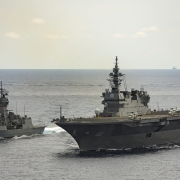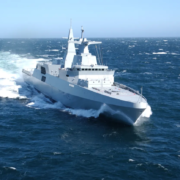Mogami class offers strong technical advantages in Australia’s frigate competition

Japan’s Mogami class is clearly the best choice for Australia’s general-purpose frigate program. Compared with its very capable competitor, the Meko A-200 from Germany, the Mogami design needs a smaller crew, offers deeper magazines and has a newer system for combat control.
The project, Sea 3000, is intended to replace the Anzac-class general-purpose frigates with as many as 11 ships, part of a larger program to expand the Royal Australian Navy’s surface fleet. TKMS’s Meko A-200 and Mitsubishi Heavy Industries’ Mogami class are the shortlisted contenders. Australia plans to order three ships of the chosen design from the winning contractor’s shipyard, taking first delivery in 2029, and build the rest locally. A decision is expected this year.
(An accompanying article looks at industrial and strategic factors in the decision.)
The Australian Defence Force has been suffering from a recruitment and retention shortfall, and the Royal Australian Navy has been especially troubled in finding and keeping people.
Minimising crew sizes is therefore more important than ever as the RAN builds up to an expanded fleet of surface combatants and nuclear-powered submarines. Because the Mogami class is designed for greater automation than the Meko A-200, it has a crew of only 90 instead of 120. So Australia’s frigates could be crewed more easily if they were Mogamis and, should the government expand the program, the smaller crew improves the practicability of operating more than 11 ships.
Alternatively, it would be more feasible for the RAN to give each frigate two rotating crews, maximising each ship’s operational availability. The United States does this with some submarines and surface ships to reduce crew fatigue and the time ships are unavailable due to crew training requirements.
Implementing a strategy of deterrence by denial requires an ability to rapidly shift mission sets, so the enemy must be wary of complex threats. If recent experience in the Red Sea is any indicator, modern naval warfare will be frenetic and victory will hinge not only on which side has the better equipment but which has the greater magazine depth.
The upgraded Mogami design offered to Australia has 32 vertical-launch system (VLS) missile cells, twice as many as the Meko A-200. Mogamis would therefore spend less time shuttling back to port for re-arming, or, if Australia follows intended US replenishment practice, undertaking exceptionally difficult reloads at sea.
The increase VLS count also gives greater flexibility in loadouts. After accounting for self-defence, the Mogamis would have greater capacity for offensive missiles than the Meko A-200. This means they can be readily retasked and kept in the fight. While frigates can’t carry as many long-range strike missiles as heavier surface combatants can, the magazine depth of the Mogami design allows for a greater distribution of weapons through the fleet, maximizing distributed lethality.
By one important measure, the combination of a small crew and deep magazines results in high efficiency: a Mogami of the upgraded design has only 2.8 crew members per missile cell, compared with 3.4 for the US Arleigh Burke class and 7.5 for the Meko A-200. Between the higher efficiency and magazine depth, the Mogami is well positioned to support the Australian strategy of defence by denial.

A ship is only as capable as the combat management system that ties everything together, however. The Meko A-200 is presumably being offered with a combat control system developed from the one that the RAN already uses in the Anzacs, offering more-seamless integration. While the current system has been improved since its initial release, its age does raise the issue of long-term upgrade costs. The price associated with updating an older baseline rapidly increases and runs into hardware limitations. A case in point is the United States’ destroyer modernisation program, which is costing an estimated $17 billion for 20 ships.
The combat management system the Mogami utilizes was developed alongside the frigate, with initial designs beginning in 2015. This newer baseline means there are potentially large long-term cost savings to be had from the Mogami class.
The RAN would need time to adjust to the new Japanese combat management system, and there would be additional costs associated with integrating weapons that Australia uses but Japan doesn’t. But these growing pains would better position the fleet for the future. Rather than presenting challenges of backwards compatibility, the combat management system would launch the RAN cleanly into the next generation of fighting ships.
Underpinning the better fit for the RAN is that cooperation with the Japanese strengthens a key geostrategic alliance between Australia and Japan. The shared operating area, threat assessments, and threat capabilities means that the Mogami is already tailor made for fighting and winning in the Indo-Pacific.
The Meko-A200 is a capable platform, and replacing the Anzac class with an upgraded variant wouldn’t be the worst choice. The Japanese bid for the Sea 3000 project, however, represents the stronger choice for Australia. The Mogami offers enhanced flexibility across the board. And there’s icing on the cake: reported costs are lower for Mogamis than for Meko A-200s.



